Buoyant most nearly means - Study guides, Class notes & Summaries
Looking for the best study guides, study notes and summaries about Buoyant most nearly means? On this page you'll find 12 study documents about Buoyant most nearly means.
All 12 results
Sort by
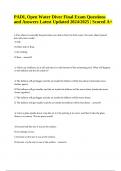
-
PADI Open Water Diver Final Exam Questions and Answers Latest Updated 2024/2025 Scored A+
- Exam (elaborations) • 22 pages • 2024
- Available in package deal
-
- $14.49
- + learn more
PADI Open Water Diver Final Exam Questions and Answers Latest Updated 2024/2025 Scored A+. If an object is neutrally buoyant (does not sink or float) in fresh water, the same object placed into salt water would A sink. B either sink or float. C do nothing. D float. - answerD 2) I blow up a balloon, tie it off, and take it to the bottom of the swimming pool. What will happen to the balloon and the air inside it? A The balloon will get bigger and the air inside the balloon will be less den...
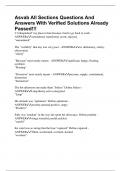
-
Asvab All Sections Questions And Answers With Verified Solutions Already Passed!!!
- Exam (elaborations) • 10 pages • 2024
- Available in package deal
-
- $12.49
- + learn more
Asvab All Sections Questions And Answers With Verified Solutions Already Passed!!!
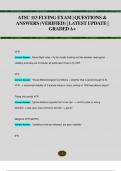
-
ATSC 113 FLYING EXAM | QUESTIONS & ANSWERS (VERIFIED) | LATEST UPDATE | GRADED A+
- Exam (elaborations) • 39 pages • 2024
-
- $13.49
- + learn more
1 ATSC 113 FLYING EXAM | QUESTIONS & ANSWERS (VERIFIED) | LATEST UPDATE | GRADED A+ VFR Correct Answer: Visual flight rules = fly by mostly looking out the window; need good visibility and stay out of clouds; all pilots learn how to fly VFR VFC Correct Answer: "Visual Meteorological Conditions = weather that is good enough to fly VFR --> horizontal visibility of 3 statute miles or more, ceiling of 1000 feet above airport" Flying into couds VFR Correct Answer: "ignore balanc...
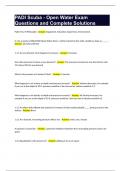
-
PADI Scuba - Open Water Exam Questions and Complete Solutions.
- Exam (elaborations) • 9 pages • 2024
- Available in package deal
-
- $13.49
- + learn more
PADI Scuba - Open Water Exam Questions and Complete Solutions Padi's Four E Philosophy - Answer: Equipment, Education, Experience, Environment 0-1 As a newly certified PADI Open Water Diver, I will be trained to dive with a buddy as deep as _____ - Answer: 18 meters/60 feet 1-1.1 As you descend, what happens to pressure - Answer: Increases How does pressure increase as you descend? - Answer: The pressure increases by one bar/ata for each 10 meters/33 feet you descend What is the ...
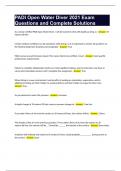
-
PADI Open Water Diver 2021 Exam Questions and Complete Solutions
- Exam (elaborations) • 26 pages • 2024
- Available in package deal
-
- $13.49
- + learn more
PADI Open Water Diver 2021 Exam Questions and Complete Solutions As a newly certified PADI Open Water Diver, I will be trained to dive with buddy as deep as - Answer: 18 meters/60 feet Certain medical conditions can be hazardous while diving, so it is important to answer all questions on the Medical Statement honestly and completely - Answer: True PADI courses are performance-based. This means that to be certified, I must - Answer: meet specific performance requirements Failure to co...
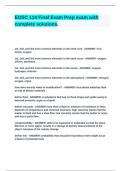
-
EOSC 114 Final Exam Prep exam with complete solutions
- Exam (elaborations) • 12 pages • 2024
-
- $11.49
- + learn more
1st, 2nd, and 3rd most common elements in the earth core iron, nickel, oxygen 1st, 2nd, and 3rd most common elements in the earth crust oxygen, silicon, aluminum Previous Play Next Rewind 10 seconds Move forward 10 seconds Unmute 0:00 / 0:15 Full screen Brainpower Read More 1st, 2nd, and 3rd most common elements in the ocean oxygen, hydrogen, chlorine 1st, 2nd, and 3rd most common elements in the atmosphere nitrogen, oxygen, argon how does density re...
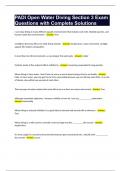
-
PADI Open Water Diving Section 3 Exam Questions with Complete Solutions
- Exam (elaborations) • 9 pages • 2024
- Available in package deal
-
- $13.49
- + learn more
PADI Open Water Diving Section 3 Exam Questions with Complete Solutions I can enjoy diving in many different aquatic environments that include coral reefs, flooded quarries, and human-made dive environments. - Answer: True Conditions that may affect me while diving include. - Answer: temperature, water movement, sunlight, aquatic life, bottom composition In most (but not all) environments, as i go deeper the water gets - Answer: colder Particles made of fine material affect visibilit...
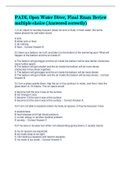
-
PADI, Open Water Diver, Final Exam Review multiple choice (Answered correctly)
- Exam (elaborations) • 13 pages • 2023
- Available in package deal
-
- $12.39
- + learn more
PADI, Open Water Diver, Final Exam Review multiple choice (Answered correctly) 1) If an object is neutrally buoyant (does not sink or float) in fresh water, the same object placed into salt water would A sink. B either sink or float. C do nothing. D float. - Correct Answer-D 2) I blow up a balloon, tie it off, and take it to the bottom of the swimming pool. What will happen to the balloon and the air inside it? A The balloon will get bigger and the air inside the balloon will be less d...
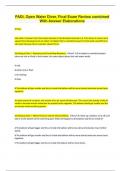
-
PADI, Open Water Diver, Final Exam Review combined With Answer Elaborations
- Exam (elaborations) • 27 pages • 2023
-
- $19.49
- + learn more
PADI, Open Water Diver, Final Exam Review combined With Answer Elaborations D float. Salt water is heavier than fresh water because it has dissolved minerals in it. This means it causes more upward force (buoyancy) on an object. An object that is neutrally buoyant in fresh water would float in salt water because there is greater upward force. See Being a Diver I - Buoyancy and Controlling Buoyancy. Ans 1) If an object is neutrally buoyant (does not sink or float) in fresh water, the same ...
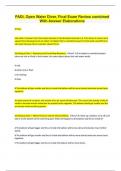
-
PADI, Open Water Diver, Final Exam Review combined With Answer ElaborationsPADI, Open Water Diver, Final Exam Review combined With Answer Elaborations D float. Salt water is heavier than fresh water because it has dissolved minerals in it. This means it c
- Exam (elaborations) • 27 pages • 2023
-
- $17.49
- + learn more
PADI, Open Water Diver, Final Exam Review combined With Answer Elaborations D float. Salt water is heavier than fresh water because it has dissolved minerals in it. This means it causes more upward force (buoyancy) on an object. An object that is neutrally buoyant in fresh water would float in salt water because there is greater upward force. See Being a Diver I - Buoyancy and Controlling Buoyancy. Ans 1) If an object is neutrally buoyant (does not sink or float) in fresh water, the same ...

That summary you just bought made someone very happy. Also get paid weekly? Sell your study resources on Stuvia! Discover all about earning on Stuvia


